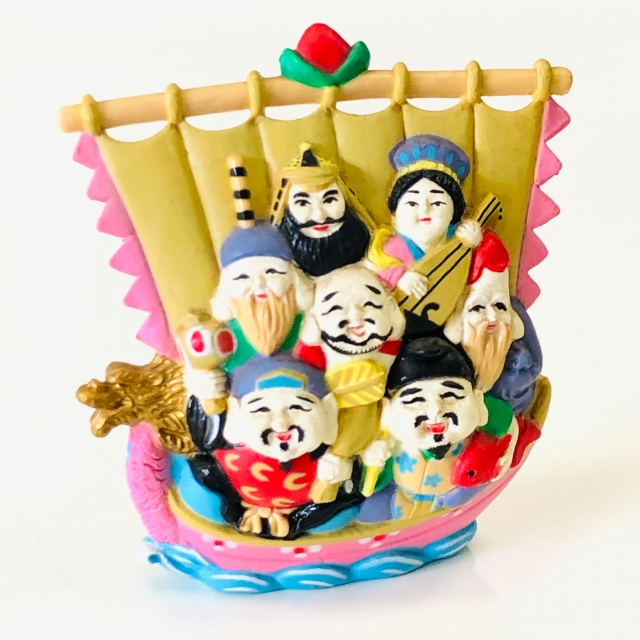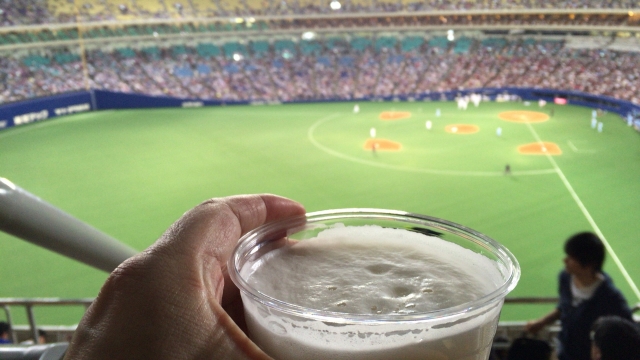The seven gods of good fortune riding on a treasure ship seem like a good omen. However, when you try to name them, you may not be able to find one or two more.
Also, when it comes to matching faces and names, it is sometimes difficult to distinguish between two elderly people. And when it comes to the origin of each person…
In this page, we will look at the names, meanings, and origins of the Seven Gods of Good Fortune.

Click here to learn Japanese language with the best one-on-one Japanese tutoring lessons in person or online.
Contents
What are the names and characteristics of the Seven Gods of Good Fortune?
First, let’s check the names and characteristics of the Seven Gods of Good Fortune. Please see the table below.
| Name | Reading | General Characteristics |
| Ebisu 恵比寿 | えびす | Fishing rods Snapper hunting clothes |
| Daikokuten 大黒天 | だいこくてん | Hammer Bag |
| Jyuroujin 寿老人 | じゅろうじん | gourd peach stag |
| Bishamonten 毘沙門天 | びしゃもんてん | Armor Treasure tower Treasure stick |
| Fukurokujyu 福禄寿 | ふくろくじゅ | Long head Long beard |
| Benzaiten 弁財天 | べんざいてん | Red one Biwa |
| Hotei 布袋 | ほてい | drum belly big bag |
* Benzaiten is often called “Benzaiten” or “Benten.
When counting the number of deities, we tend to say “one or two…” However, since they are deities, not people, the correct way to count is “one pillar (hitohashira), two pillars (futahashira)…”.
In common usage, the gods are counted as “Isshin (one god), Nishin (two gods)…”.
Since there is no pecking order or hierarchy among the Seven Gods of Good Fortune, the order is easy to remember.
They are golden in color and look very auspicious.
What are the meanings and origins of the Seven Gods of Good Fortune?
Let’s look at the meaning and origin of each of the Seven Gods of Good Fortune.
Ebisu 恵比寿
Ebisu is the only one of the Seven Gods of Good Fortune and is an ancient Japanese deity.
Originally, he was the god of “great catch and good fortune,” but eventually he became the god of “good harvest” and “prosperous business” as a god of good fortune.
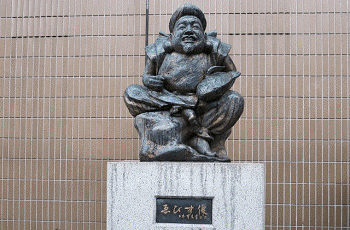
Daikokuten 大黒天
Originally, Daikokuten was the Indian Hindu incarnation of Shiva, Mahakala.
The name “Daikokuten” was given because “maha” means large and “kala” means black.
Daikokuten was combined with the Japanese deity Okuninushi no Okami to become the god of wealth and food.
It is said that the two deities were combined because “Okuni” and “Daikoku” read as “daikoku” in Japanese.
Okuninushi is famous for the story of the “White Hare of Inaba”.
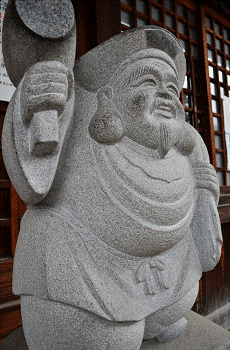
Jurojin 寿老人
Jurojin is a Chinese Taoist goddess who is believed to be an incarnation of the South Pole Star. He is sometimes referred to as “Shirahige Myojin,” one of the Seven Gods of Good Fortune in Japan.
He is considered to be a god of longevity who likes to drink.
Jurojin’s gourd contains an elixir of immortality and he often carries a peach of longevity.
He is also sometimes accompanied by a stag, signifying the harmony of nature and longevity.
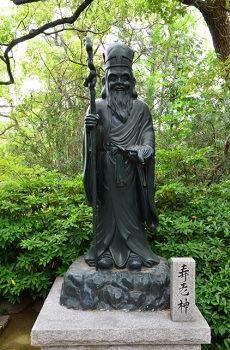
Bishamonten 毘沙門天
Originally the Hindu god Kubera of India, he was the god of warfare, but later came to be worshipped as a god of promoting good fortune.
In Japan, he is called “Tamonten” when he is one of the Four Heavenly Kings, and “Bishamonten” when he is the sole deity. The figure wearing armor is said to be an older form of Ebisu.
Since the Middle Ages, Bishamonten has been as popular as Ebisu and Daikoku, and since the Edo period (1603-1867), he has been worshipped as a god of fortune in the fight for victory.

Fukurokuju 福禄寿
A Chinese Taoist deity, he is said to be an incarnation of the star Tiannan or the South Star, and is sometimes said to be the same deity as Jurojin.
He is considered to be the god of longevity and good fortune, and is often accompanied by a crane.
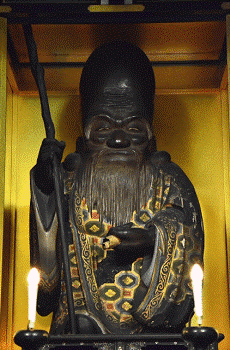
Benzaiten 弁財天
Of the seven gods of good fortune, Benzaiten is the only female deity.
Originally the Indian Hindu goddess Sarasvati, she was later combined with Japanese deities to become a heavenly maiden with the virtues of music, wealth, and wisdom.
Buildings with Benten as their principal deity are often named Benten-do or Benten-sha.
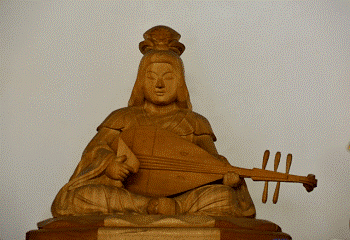
Hotei 布袋
A Buddhist monk who is said to have existed at the end of the Tang Dynasty in China, Hotei is also said to be an incarnation of Miroku Bosatsu (Maitreya Bosatsu).
The name “Hotei” is a common name given to the monk because he always carried a large sack on his back.
In Japan, Hotei has been the subject of Zen paintings since the Kamakura period (1185-1333), and has been regarded as a god of wealth, prosperity, and good character.
The pouch carried by Hotei is also called “Kannin-bukuro” (bag of endurance).

History of the Seven Deities of Good Fortune
The Seven Deities of Good Fortune took many years to take their present form. Let us look at their transformation over time.
The Eight Immortals in China
In China, there were eight hermits (hachisen), similar to the seven gods of good fortune, all of whom are said to have been actual hermits.
Paintings depicting these eight hermits have become objects of worship, and many of these paintings show all eight hermits on a boat.
This has led some to believe that the origin of the Seven Gods of Good Fortune is derived from the Chinese eight hermits.
Let us list the names of the eight hermits.
- Kasenko (何仙姑) (カセンコ) * the only female deity
- Han Xiangzi (韓湘子) (カンショウシ)
- Han Jong-ri (韓鍾離) (カンショウリ)
- Jogukwu Alexandria曹国舅(ソウコクキュウ)
- Choukalou張果老(チョウカロウ)
- Lan Sai Wah藍采和(ランサイワ)
- Li Tieguai李鉄拐(リテツカイ)
- Lido Bin呂洞賓(リョドウヒン)
Conclusion
The Seven Gods of Good Fortune are seven deities who bring good fortune. They are composed of Buddhist, Shinto, and Taoist deities and saints, and are often depicted riding on treasure ships.
It is said that following the Chinese legend of the seven saints, people in Japan began to collect and worship seven auspicious deities.
Although the Seven Gods of Good Fortune became popular during the Muromachi period (1333-1573), even today, people pray for longevity and family safety at temples and shrines associated with the Seven Gods of Good Fortune, and merchants sometimes display pictures of the Seven Gods of Good Fortune to wish for prosperous business.
Related article:

